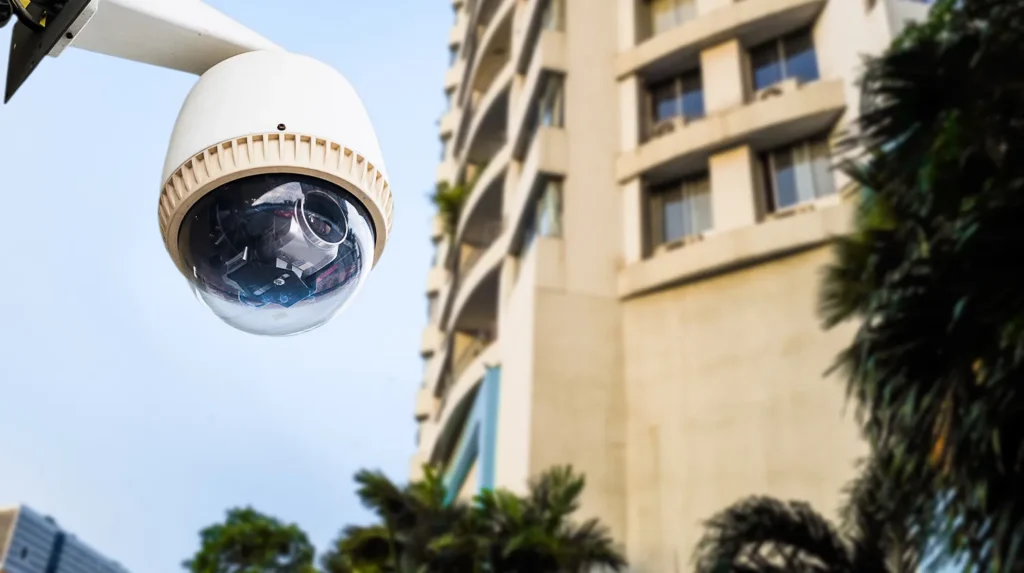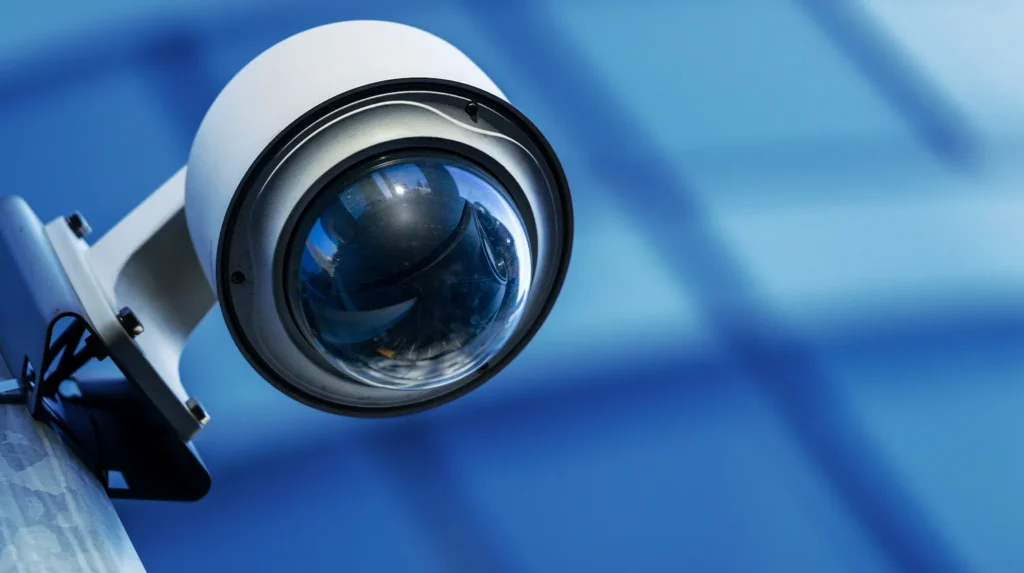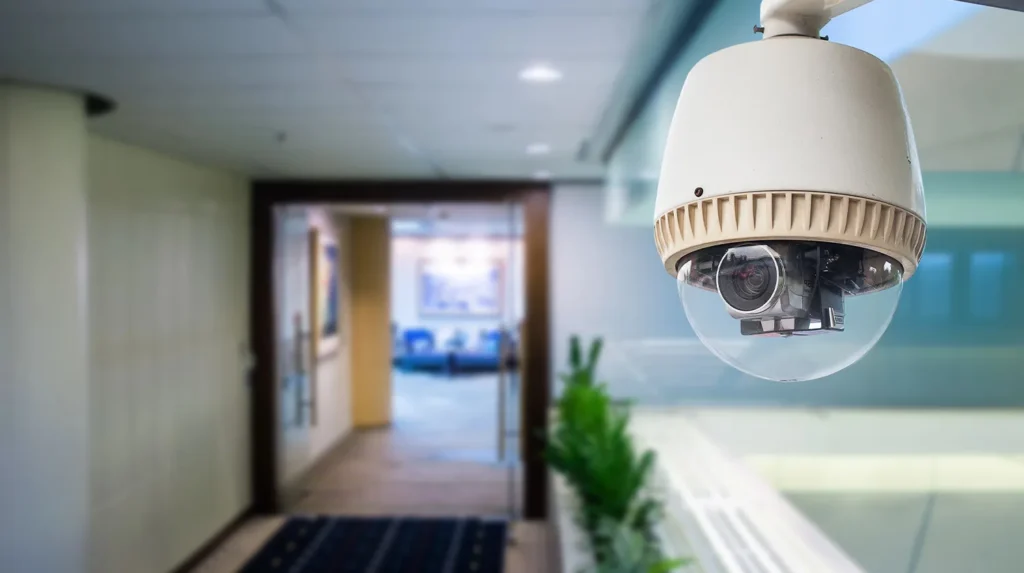What is a PTZ camera and how can it help you? In this guide, you will learn about PTZ cameras, their features, and which one is best for your surveillance or live streaming needs.
Key Takeaways
PTZ cameras offer enhanced surveillance via their pan, tilt, and zoom capabilities. This makes them ideal for monitoring large areas with fewer cameras, which creates a comprehensive PTZ camera system.
There are different types of PTZ cameras, including IP, Analog, and Wireless. They each have advantages and connectivity options and can be used for different surveillance needs,
Choosing the right PTZ camera requires careful consideration. How will they be used? What is your budget? What are the environmental factors in your area?
Understanding PTZ Cameras

Pan tilt zoom cameras, also known as PTZ cameras, are designed to sweep across a large area with their pan, tilt, and zoom functions. This flexibility makes them perfect for monitoring big areas where fixed cameras aren’t sufficient. By providing more coverage with fewer cameras, using PTZ cameras can provide enhanced security and cost savings compared to multiple camera installations.
PTZ cameras offer high video quality and remote-control capabilities. A PTZ security camera provides advanced features such as pan-tilt-zoom capabilities that enhance situational awareness over large areas. Some models also have auto-tracking powered by AI. These advanced features make them suitable for various uses from security monitoring in big spaces to live streaming where having full control of the viewing angles and functions is crucial. Knowing the basics and the latest features of PTZ technology is important when choosing the right equipment for your needs.
What is a PTZ Camera?
PTZ cameras are special devices that can pan, tilt, and zoom to provide wide coverage and focus on specific areas. They differ from IP cameras because they have motorized parts that can move in different directions. This feature is useful for following moving objects or changing viewing angles on the fly. That’s why PTZ cameras are valuable for continuous and flexible security monitoring in big outdoor spaces and small indoor areas, making them an essential part of any PTZ camera system.
With modern network technology, these PTZ cameras can stream video and be controlled through dedicated smartphone apps or software. Some of the higher-end models have AI features that can auto-track humans or vehicles – a big plus for securing sensitive areas.
Each model has a different visibility range to handle different surveillance needs. Whether you need short-range or long-range monitoring, there’s a PTZ camera for your business.
Key Features of PTZ Cameras
When choosing a PTZ security camera, consider the zoom range, image resolution, and connectivity options. Optical zoom is a must-have feature that allows users to get clear and sharp images from long distances. This is important for recognizing people and monitoring wide areas. High-quality sensors and durable construction are key to the camera’s performance and longevity.
Auto tracking and remote control make PTZ cameras more versatile. These features give the cameras unmatched accuracy and flexibility.
Through its remote-controlled pan tilt and zoom features, these cameras give properties full coverage to a variety of applications including but not limited to security monitoring or live streaming events, to provide full control of what is being monitored.
Optical Zoom
Optical zoom is an important feature in PTZ cameras, as it allows the user to zoom in on a subject without sacrificing image quality. Unlike digital zoom which can pixelate and lose detail, optical zoom uses the camera’s lens to adjust the focal length, giving a clear and sharp image even at high zoom levels. When choosing a PTZ camera, consider the optical zoom range, which is measured in terms of the camera’s focal length (e.g. 4.3-129mm). A higher optical zoom range (e.g. 30x or 40x) gives more flexibility for capturing far-off objects. This is very useful for surveillance and image quality when capturing details from long distances.
Pan and Tilt Range
The pan and tilt range of a PTZ camera determines its coverage area. Look for cameras with a pan range of at least 340° and a tilt range of -30° to 90°. This allows the camera to view a wide area and is perfect for monitoring big areas like parking lots, stadiums, or industrial yards. Some PTZ cameras also have a “flip” feature which allows the camera to rotate 180°, giving an even wider range of motion. This range allows the camera to monitor large spaces with fewer units, to minimize the need for fixed cameras.
Types of PTZ Cameras

PTZ cameras can be categorized into three types based on their connectivity and features: IP PTZ cameras, Analog PTZ Security Cameras and Wireless PTZ Cameras. Each type has its own advantages for specific use, so it’s important to know the differences when choosing a camera for your needs.
For example, IP PTZ security cameras are designed for networked systems. Because of their simplicity and reliability, analog PTZ security cameras deliver high-definition video through coaxial cables.
Wireless PTZ security cameras can be placed anywhere without the need for extensive cabling. Their flexibility makes them perfect for situations where it is necessary to move or reposition.
IP PTZ Cameras
IP PTZ cameras are popular in modern security systems because of their enhanced network integration and connectivity features. Cameras that use Power over Ethernet (PoE) combine power supply and data transmission into one Ethernet cable, making setup easier while using less wiring. PTZ cameras with Wi-Fi also provide more placement flexibility and easy installation.
These cameras are equipped with high-end imaging technology that caters to different operational needs by using both visual and thermal detection. Remote control through a network connection adds to their flexibility, so they can be controlled and monitored from anywhere.
Analog PTZ Security Cameras
PTZ cameras that use HD over Coax technology offer reliable high-definition surveillance and effective video transmission. Its simple design only needs one coaxial cable to transmit video and control signals, so installation is easy. To record and manage camera footage, users must have a Digital Video Recorder (DVR) in place.
Despite IP PTZ security cameras being newer to the market, analog PTZ security cameras are a seasoned option for different surveillance needs because of their longevity in the industry. These cameras can deliver HD-quality video through one coaxial wire, making them a great option for properties that want to upgrade their existing analog system without disruption and complexity.
Wireless PTZ Cameras
Wireless PTZ cameras use Wi-Fi to transmit video and data. This makes for flexible placement and easy installation. Without the need for complex cabling, they are ideal for temporary locations or areas where cabling is difficult. However, these cameras must be placed near a power supply and within reach of a strong Wi-Fi signal to function well.
Often used in video conference rooms, concert venues, live events, and educational settings, wireless PTZ cameras stand out because of their remote control capabilities and easy movement navigation. Their strength lies in their ability to scan wide spaces seamlessly and change viewing angles instantly, making them a versatile tool for multiple uses.
Applications of PTZ Cameras

Cameras with a PTZ (Pan-Tilt-Zoom) feature are very flexible for multiple uses, including but not limited to security surveillance, live streaming, and video monitoring. The ability to change viewing perspectives and the powerful zoom features deliver effective coverage for larger areas and can often reduce the total number of cameras needed to monitor the space.
For active monitoring situations — like large outdoor events, industrial sites, or big indoor areas — PTZ cameras can be very useful. Their ability to cover wide areas using fewer units not only enhances security but can also be cost-effective.
Security Surveillance
PTZ cameras are essential for security surveillance, providing a wide coverage area and high-quality video data. Their effectiveness is most evident in large spaces like stadiums, industrial sites, and parking lots where standard security cameras may not be sufficient. These PTZ units are usually installed on walls or ceiling to maximize scene visibility and enhance monitoring capability.
We must not forget the limitations of PTZ cameras despite their advantages. They can’t provide complete 360-degree visual coverage and are challenged to follow rapid movements. This limitation can reduce their effectiveness in situations that require tracking high-speed subjects or events.
Live Streaming Projects
In any live streaming project, PTZ cameras excel for their flexibility and control over video capturing processes. This makes them ideal for recording live events. The remote-control capability allows the operator to change the zoom level and camera angle in real time, to get the best visual experience. This is very important during concerts or conferences where fixed-lens cameras may not suffice.
PTZ cameras can take a broadcast to the next level by allowing users to zoom in on specific parts of the event. This can help improve content and give a professional look to the stream.
Monitoring and Recording
PTZ cameras excel in providing continuous monitoring and recording, an essential tool for security purposes. The continuous recording capability of these cameras helps ensure important incidents are captured. This non-stop monitoring is very useful for security personnel who monitor multiple locations at the same time. Not only can these PTZ cameras permit live viewing, but they can also archive footage for later review. This feature is very useful for post-event analysis and identification.
Stealth Monitoring often uses PTZ cameras for its live video monitoring solution. The pan, tilt, and zoom feature provides Stealth trained operators the ability to track and respond to suspicious activities in real time. This level of control lets Stealth’s security team monitor wide areas where potential threats can be detected, zoom in for detailed views, and quickly assess unfolding situations.
Stealth uses these cameras with sophisticated video analytics software to distinguish between harmless activity and a potential security threat. This intelligent automation amplifies the effectiveness of Stealth’s security services and allows its monitoring staff to focus on real incidents that require human intervention. This provides more efficient and reliable protection for its clients.
License Plate Capture
PTZ cameras are not specifically designed for license plate capture, but some models can capture license plates in certain conditions. However, due to motion blur, it can be hard to capture clear images of license plates on moving vehicles. If license plate capture is a requirement, consider using a camera with license plate reader technology or a PTZ camera with advanced auto-tracking features and high frame rates. These can help reduce motion blur and capture license plates clearly and accurately even in dynamic environments.
Advantages and Limitations of PTZ Cameras

PTZ cameras are popular as a security tool and for video production because of their many advantages. However, there are also some drawbacks that must be taken into account. It’s important to understand the pros and cons to determine if PTZ cameras fit your needs.
Advantages
PTZ cameras have a great optical zoom that can capture details on objects that are far away. This is extremely useful for surveillance when the need to recognize features from a distance is important. High-quality PTZ cameras also excel in low-light conditions due to increased sensor sizes.
These cameras produce high-resolution images that allow the user to identify people and monitor different areas. The flexibility of PTZ cameras extends to their remote-control options which can be accessed through mobile apps and software. Additional features like motion-activated recording can enhance their efficiency by capturing only relevant events.
Limitations
While PTZ cameras offer many benefits, they also have a few drawbacks. One of the main disadvantages is that they can be more expensive than using several fixed cameras to cover the same area. Their installation may be more challenging and require specialized knowledge which could add to the total cost.
In situations involving fast movements, PTZ cameras may have trouble capturing clear images due to motion blur. This can be a problem when trying to capture details like license plates on moving vehicles. Although they can produce high-quality images in different situations, their performance may not be adequate when objects are traveling at high speeds.
Choosing the Right PTZ Camera
When choosing a PTZ (pan-tilt-zoom) camera, consider its purpose, your budget, and the environment where it will be used. Many models cater to different uses. Make sure to assess your needs first before selecting.
Considerations for Purchase
When choosing a PTZ camera, consider its purpose, because as previously mentioned, different models are used for different applications. Also, consider your budget which will dictate the features and models within your reach. So, weigh the cost against the requirements.
Remember that lighting and environmental conditions can affect a camera’s performance. Choose a model that can operate well in the condition you may encounter.
Installation and Setup
Make sure PTZ cameras are installed and set up correctly for optimal performance to monitor their designated areas. Regular firmware updates and check-ups can improve functionality and potentially add new features. Regular maintenance of the cameras is important to extend their lifespan and performance.
Network and Power Requirements
PTZ cameras need a reliable power and network connection to operate. Power over Ethernet (PoE) is a common way to operate these cameras. It supplies power and data through one single Ethernet cable making installation easier. This eliminates the need for additional cabling and makes setup more efficient.
Having an uninterrupted internet connection is important for remote access and management of PTZ cameras on a local network. A stable connection can be achieved by using CAT5 or RG59 Siamese cables that have adaptable wiring options. To avoid issues with your PTZ camera, make sure the voltage from the power supply matches the camera requirements.
Maintaining Your PTZ Camera
Consistent maintenance of your PTZ cameras is a must to ensure optimal performance. Clean the lens and enclosure regularly to prevent image degradation and reduce wear and tear of moving parts.
Stealth Monitoring offers professional cleaning services to help keep cameras in the best working conditions. They use specialized equipment and techniques to ensure cameras are free from dirt, dust, and debris. This helps guarantee clear and reliable footage.
Regular Maintenance Tips
In addition to cleaning, having a regular maintenance schedule is important to help detect any issues early and prevent camera downtime. Stealth implements tailored maintenance schedules to help make sure any potential issues are addressed before they affect operations.
Troubleshooting Common Issues
If you can’t connect to your PTZ camera, start by checking the power supply and make sure all connections are secure. If PTZ control is not responding, check the serial communication settings of the camera and encoder to make sure they are consistent. Adjusting this might fix the issue.
If restarting the priority service of your PTZ doesn’t work or the camera is unresponsive, this might indicate a more serious issue like a communication breakdown or motor defect. In this case, consult an expert.
Harness the Power of PTZ Cameras

PTZ cameras with pan, tilt, and zoom capabilities are a great option for surveillance and live streaming. These cameras can cover large areas through their movement and produce high-quality video output. This makes them perfect for monitoring big spaces or recording live events. To make the most of PTZ cameras in your monitoring or broadcasting needs, it’s important to research the different models, their features, and what factors to consider when choosing and maintaining them.
To get more information about PTZ cameras and how they benefit proactive security solutions like remote video monitoring, contact us.
Frequently Asked Questions
How do IP PTZ cameras differ from analog PTZ cameras?
IP PTZ cameras differ from analog PTZ cameras primarily in their streaming capabilities and network connectivity. IP cameras deliver higher image quality and greater flexibility. Analog cameras rely on HD over Coax technology for video transmission.
What are the key features to look for in a PTZ camera?
The key features to look for in a PTZ camera include optical zoom, resolution, auto-tracking, remote control capabilities, and various connectivity options, as they greatly influence its performance and usability. Prioritizing these aspects will ensure a more effective surveillance experience.
Can PTZ cameras be used for live streaming projects?
Yes, PTZ cameras can be used for live-streaming projects. In fact, PTZ cameras are often used in live streaming applications due to their ability to provide high-quality video and complete control over the camera’s field of view.

